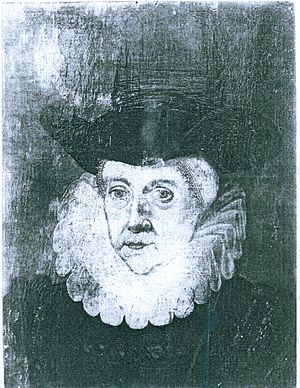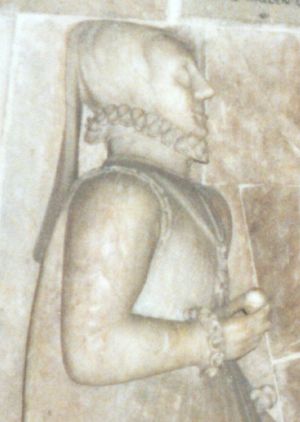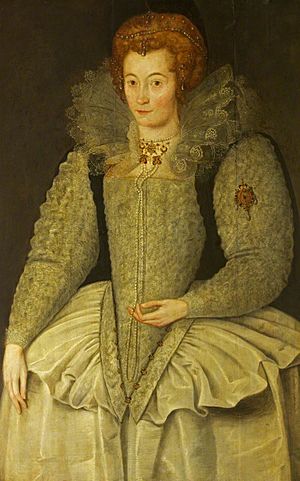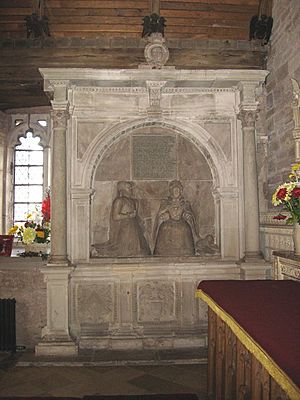Blanche Parry facts for kids
Blanche Parry (born 1507 or 1508, died 1590) was a close friend and trusted helper to Queen Elizabeth I. She came from a place called Newcourt in Bacton, England. Blanche worked for Queen Elizabeth for many years. She was the Chief Gentlewoman of the Queen's special room, called the Privy Chamber. She also looked after the Queen's valuable jewels.
Contents
Who Was Blanche Parry?
Blanche Parry was born at Newcourt in Bacton, Herefordshire. Her father was Henry Myles, who was a sheriff in Herefordshire three times. Her family was related to important Welsh families, like the Herberts and the Stradlings. Her mother was Alice Milborne. Blanche's family had been important people in the border areas between England and Wales for a long time.
Blanche's Early Years
Blanche grew up speaking both Welsh and English. This was because of her family's background in the Welsh Marches. She and her sisters were educated by nuns at a place called Aconbury.
Life at the Royal Court
Blanche Parry came to the Royal Court with her aunt, Blanche, Lady Troy. Her aunt was a teacher to young Prince Edward (who became Edward VI) and his half-sister Elizabeth.
Blanche Parry started working for Elizabeth when Elizabeth was born in 1533. She was about 25 or 26 years old at the time. Blanche stayed with Elizabeth almost constantly until her own death. She even stayed with Elizabeth when she was held prisoner in the Tower of London before she became queen. Blanche wrote on her tomb that she "saw [Elizabeth's] cradle rocked."
After Elizabeth became Queen in 1558, Blanche became a very important person. She was named the Chief Gentlewoman of the Privy Chamber. This meant she controlled who could see the Queen.
Blanche was also in charge of the Queen's jewels even before Elizabeth became queen. She also looked after the Great Seal of England for two years. She managed the Queen's personal papers, clothes, furs, and books. Many of these items were gifts given to the Queen. Blanche also handled large sums of money for the Queen.
She helped the Queen by passing on important information. For example, she got news from her nephew during a rebellion in 1569–1570. She also received new laws (called bills) for the Queen to review. Blanche even wrote letters for the Queen. She also supervised the Queen's linen and other personal items, including the Queen's pet "musk cat" (which was probably a ferret).
Blanche Parry was very powerful because she was so close to the Queen. People knew she could help those who were in trouble with the Queen. She was good friends with her cousin, William Cecil, who was the Queen's main advisor. They worked together closely.
Blanche received many rewards from Queen Elizabeth. These included land in Herefordshire, Yorkshire, and Wales. Records also show she often received clothes that the Queen had worn.
Blanche also gave gifts to the Queen. For example, she gave silver dishes and boxes. In 1572, she gave the Queen a gold flower with rubies and diamonds. In 1573, she gave a jewel made of mother-of-pearl with gold chains. In 1575, she gave another gold flower with roses and a small fly.
In 1584, Blanche asked for the first known map of Llangorse Lake to be made. This was to help with a court case she was involved in. After 1587, another courtier, Mary Radcliffe, took over looking after the Queen's personal jewelry. Blanche made a detailed list of all the jewels, which is now kept at the British Library. This list included 628 pieces. William Cecil helped Blanche with her wills.
Blanche Parry's Death and Burial
Blanche Parry died on February 12, 1590, when she was 82 years old. She was buried in St. Margaret's Church, Westminster. The Queen paid for all her funeral costs.
There are two monuments (memorials) to Blanche Parry. One is in St. Faith's Church in Bacton, Herefordshire. The other is her tomb in St. Margaret's, Westminster.
Thomas Markham sent news of her death to the Earl of Shrewsbury. He wrote, "On Thursday last Mrs Blanshe a Parrye departed; blind she was here on earth, but I hope the joys in heaven she shall see."
Monument in St Margaret's Church, Westminster
Blanche Parry's monument in St Margaret's Church, Westminster, is made of marble and alabaster. It shows a sculpted and painted image of Blanche kneeling at a prayer desk. Above her are her family's coat of arms. The monument was paid for in 1595/6.
The inscription on the monument says: "Here lies Blanche Parry, daughter of Henry Parry of New Court in Herefordshire. She was a Gentlewoman of Queen Elizabeth's special room and keeper of her jewels. She served her faithfully from the Queen's birth. She was kind to her family and countrymen, and generous to the poor. She gave 140 bushels of wheat and rye every year forever to the poor of Bacton and Newton in Herefordshire. She also gave money to Westminster and other places for good causes. She died a maiden at 82 years old on February 12, 1589." (Note: The year 1589 here refers to 1590 in our modern calendar).
Monument in Bacton Church
Blanche Parry had planned to retire to her family home in Newcourt. So, she had a monument made for herself in the church in Bacton. This monument shows sculptures of both Blanche and the Queen. It also has a long inscription with 28 lines, which Blanche probably wrote herself.
This monument was made before November 1578. It is the earliest known picture of Queen Elizabeth I shown as "Gloriana." This was a special way of showing the Queen as a powerful and pure ruler. The monument helped spread the Queen's image and idea of her as a virgin queen beyond the royal court. The inscription was meant to show how close Blanche was to the Queen. It also helped strengthen the Queen's image with lines like "With maiden Queen a maide did end my life." The statue of Blanche praying before the Queen uses religious images, like those of the Virgin Mary.
Some stories say that Blanche's internal organs or heart were buried in her monument in Bacton Church, but there is no proof of this.
The Bacton Altar Cloth
There is a special cloth at Bacton Church called the Bacton Altar Cloth. For many centuries, people believed it was very precious. In the 1870s, some thought Blanche Parry herself had embroidered it.
In 1909, the church's rector, Charles Brothers, had the cloth framed and displayed. He was the first to suggest that the Bacton Altar Cloth came from a dress belonging to Queen Elizabeth I. This idea was later supported by Lionel Cust, an expert who saw similar designs in portraits of the Queen. Cust thought the Queen might have given the cloth as a gift to Blanche Parry, who then gave it to her church.
Experts now say the cloth was made in the late 1500s. While there's no official paper saying it belonged to Queen Elizabeth, curators believe it is very likely it was once hers. We now know that this very expensive fabric was first embroidered with beautiful designs and made into a dress for the Queen. Later, the dress was taken apart. The cloth was then embroidered with more designs and sewn into an altar cloth. Finally, it was sent to Bacton Church in memory of Blanche Parry. So, Blanche Parry didn't own it, but it was sent to the church because of her, possibly by the Queen herself.





